1970
This was the decisive year for Natalia LL as she decidedly exposed her artistic attitude and the links with neoavanguard art. In March she participated in Visual Arts Symposium Wrocław ’70 where, together with Z. Dłubak and A. Lachowicz, presented “Set of Optical Tools RELOP” which after proposed location in a urban space was expected to give some unusual possibilities of viewing the common places of living. This work represented the programme of art where a creative process alone was important, not a material object. In August at Visual Artists Meeting in Osieki she showed two works: “Permanent registration — Upper Odra River” and “Warrant of Arrest” which were attempts of “Idea Art” where in the place of verbal instructions were presented series of photographs.
In December 1970, together with Zbigniew Dłubak, Andrzej Lachowicz and Antoni Dzieduszycki, founds PERMAFO Gallery in Wrocław (functioning till 1981). The gallery was in fact half formal agreement of artists made to promote an actual art through exhibitions, actions and publications. PERMAFO manifesto stated among others: “A lens of camera or film-camera and light sensitive materials can witness phenomenon that escape us from one second to another. (…) We can get closer to the knowledge of the present only when we will perceive more signals from reality. A condensation of their registrations is a warrant for reduction of deformations and mistakes resulting from a selection based on customs, conventions and traditions. The state of ideal registration results from receiving and recording all signals coming from reality — so it is the reality itself (…) We understand that biological and psychological structure of a man enables him receiving all the signals from reality, so we face the necessity of choice. Understood in such a way, CHOICE = ARTISTIC CREATION. (…) What interests us is only the reality (…)”
As Natalia LL said about that: “We wanted to treat photography as a ‘transparent’ notation where any decorativeness or visual illusion would be reduced to a minimum. PERMAFO (understood as a permanent formalisation) was intended to be a structure enabling us to show the attitude that is aimed at investigation into and not expressing art.”
Participation in exhibitions:
— Visual Arts Symposium Wrocław ’70, Museum of Architecture, Wrocław
— “Proposition I” and “Proposition II”, exhibitions after Visual Artists Meeting in Osieki
— SP (Idea Art), Gallery “Pod Moną Lizą”, Wrocław (works: Permanent registration — 24 hours, and Warrant of Arrest) The exhibition was made of content of one of 300 identical envelopes which contained the same material and were 300 originals of the exhibition.
— All-Polish exhibition of photography “Portrait”, CBWA Warsaw (prize)
— Polish Photography, Copenhagen
— Foto ’70, District Exhibition ZPAF, BWA Wrocław
Permanent measurement of time, 1970
Permanent measurements every 1km of the E22 motorway, 1970
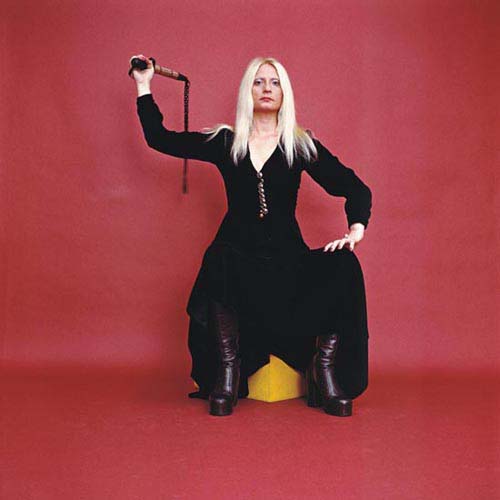
Velvet terror, 1970
photograph 100x100cm

Velvet terror, 1970
photograph (nine elements) 300x300cm
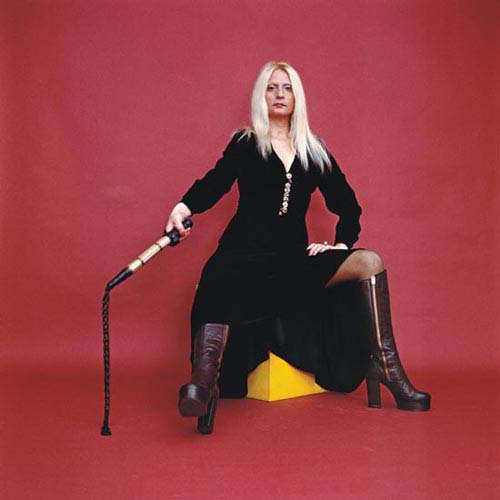
Velvet terror, 1970
photograph 100x100cm
1971
In a PERMAFO Gallery activity begins with her individual exhibition “Intimate photography”, where she made space arrangement using also her earlier “erotic” photographs. In the catalogue text she said: “I am interested in a visual photography where sign and significance are of the same value. I do not want to repeat the existing explanations concerning the notion of visual photography — I will explain my view on the semantic, notional layer of photography. Photographic shots, made with a fascination of an immediate fixation of an event, mostly suffer from a serious defect: they in some way only skim over the surface of the essential. The situation is even worse because of the rich tradition which imposes the rules of composition that artificially help to create “artistic pictures”. The only sensible for me photographic method is a registration of an assumed a priori conception, notion. I am not interested in an aesthetizing photography and for that reason I used the term of “intimate photography” which has a sense both in the sphere of creation and perception.”
Individual exhibitions:
— Intimate Photography, PERMAFO Gallery, Wrocław
— Mutants (together with Z. Dłubak and A. Lachowicz), Gallery „Pod Moną Lizą”, Wrocław
— Mutants-RELOP (together with Z. Dłubak and A. Lachowicz), Współczesna Gallery, Warsaw
Participation in exhibitions:
— Searching Photographers, Współczesna Gallery in Warsaw and following expositions in Milan, Parma, Torino
— Symposium “Golden Grape”, Muzeum Ziemi Lubuskiej, Zielona Góra (spherical projection of 1500 photographs of erotic scenes)
— III Triennale of Drawing, Architecture Museum, Wrocław
— All-Polish exhibition “Theatrical drawing Wrocław”, Wrocław
— Foto-71, District Exhibition ZPAF, BWA Wrocław
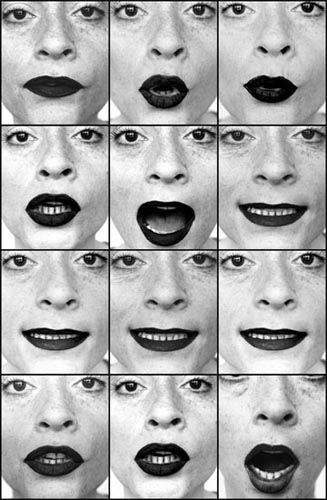
Word, 1971
photographs 400x270cm
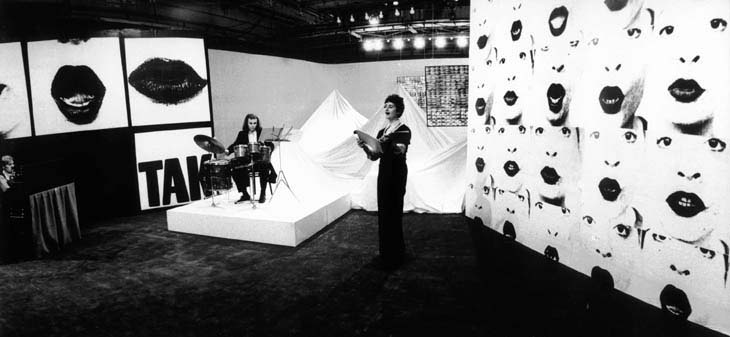
Word, 1971
installation, Modern Polish Music Festival, Wrocław
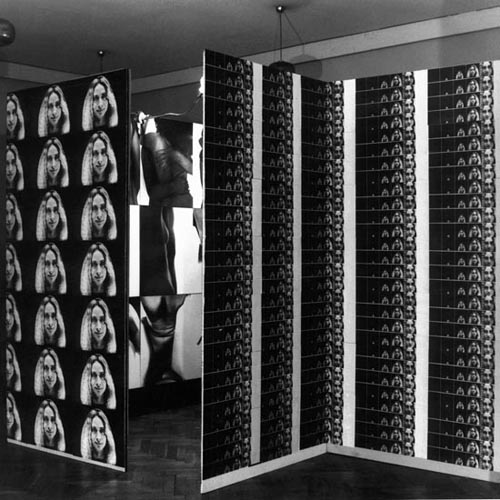
Intimate photography, 1971
installation 220x200x200cm, exhibition: Intimate Photography, Galeria PERMAFO, Wrocław
1972
Continues her work with photographic and film registrations of different everyday functions, which are then presented in different forms. In the text “Transformative Attitude” she writes among others:
“Art realizes itself in every moment of reality, every fact, every second are for us the very fact and the very second which cannot be repeated. That is why I record common and trivial events like eating, sleeping, copulation, resting, speaking, etc. Moreover each activity of a man being a component of his reality is absolutely equal in evoking mental reaction in a man who watches the notation. That is why I can transform a registration of one activity into another one. It is not substance and a formal appearance which are essential but an effect, that is meaning.(…)” (text from 1972, published in “Heute Kunst” 9/1975, Düsseldorf)
Begins the cycle of paintings uniform in colour, according to chosen length of light wave, measured in Kelvin scale degrees.
Individual exhibition:
— The Word (film show), PERMAFO Gallery Wrocław
These were recordings of a face pronouncing a word, also there existed photographical versions which were already demonstrated at “Golden Grape” exhibition in 1971.
Participation in exhibitions:
— NS — New Situation (the publication and the show organized by PERMAFO Gallery, which was the review of 8 artists works demonstrated on printed reproductions). The exhibition was presented in Współczesna Gallery in Warsaw, Muzeum Sztuki in Łódź, and in Georg Eastman House in Rochester. Commenting this exhibition and Natalia LL works, Jan Świdziński stated among others: “Photographic documentation is a new reality which can be confronted and compared with the photographed reality. Art is no longer a phenomenon excluded from the process of reality, a throw back towards past reality. It becomes a process that generates successive phases of reality. It is the reality itself, a factor co-creating the structure of the world we are stuck, an act of a social activity.” (Photography, Warsaw, no. 5/1972)
— The Show of 12, PERMAFO Gallery, Wrocław
— Turów 71 (exhibition after workshop), BWA Wrocław
— Atelier 72, Edinburgh International Festival, Demarco Gallery, Edinburgh (work: Intimate Photography)
— Polish Photography, Buenos Aires
— Polish Contemporary Photography, Foundation Patio, Geneva; and Kunsthalle, Nuernberg
— Films, PERMAFO Gallery, Wrocław
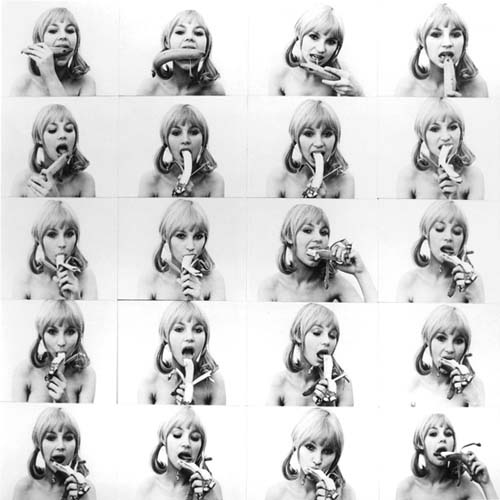
Consumer art, 1972
photographs 100x100cm
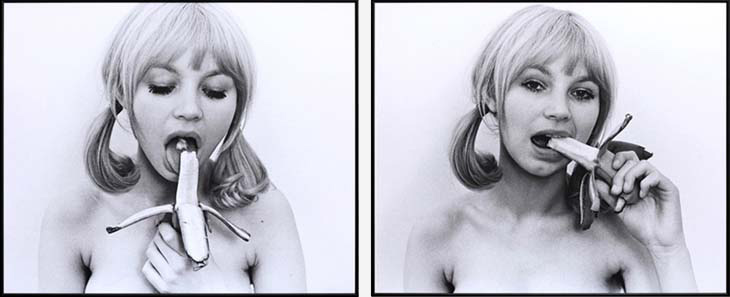
Consumer art, 1972
photographs 2x 50x60cm
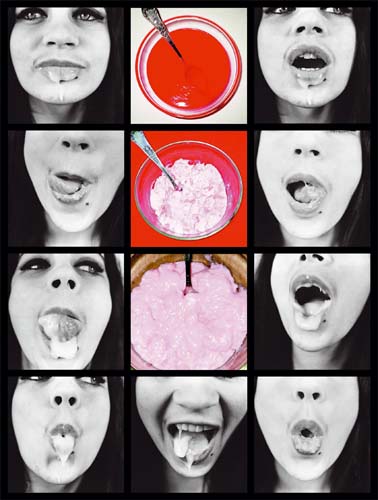
Consumer art, 1972
photograph 400x300cm
1973
After the period which Natalia LL called as the phase of “permanent registration” (1970—1972) she begun the series of film and photographical realisations entitled “consumer art”, where she exposed changes of meanings of a simple act of consumption (1972—1975). Antoni Dzieduszycki in the article about Natalia LL (Fotografia, Warsaw no. 7/1973) stated among others:
“This particular fascination that occurs from the contact with the works of Natalia LL comes also from the fact that the artist works in a rational, strictly disciplined way. This rationalism and discipline don’t result only from the fact of formal order based on vertical and horizontal rows of photographs. This system of signs repetition is the result, the necessity of just such shaping and it is the consequence of the general creative attitude of the artist. (…) In the works of Natalia LL registered are first of all functions, activities which further transform into gestures and then gestures transform into signs. (…) The sense of that is most distinctly visible in the last cycle of Natalia LL_:_ “Consumer photography”. The double meaning of the function which changes from the simple act of eating into sophisticated erotic and finally into almost magic gesture — into a system of signs of seemingly common yet unknown for us code — is not only intriguing us but also makes us to reflect upon the sign, upon codes that we use everyday to communicate. And this reflection which finally becomes a reflection made by art upon art is undoubtly one of the most precious artistic achievements of Natalia Lach-Lachowicz.”
In December 1973 the booklet “Permafo-Sum. Natalia LL works 1970—1973” is published by PERMAFO Gallery. The content of the booklet are series of photographs of “permanent registration” and “consumer art” alternating with recordings of artist’s name undergoing transformations. This emphasized differences of visual and verbal codes, and also a continuity of changes and their ambiguity.
Individual exhibitions:
— Consumer Art, PERMAFO Gallery, Wrocław
The exhibition was in two parts located in different places. In one place exhibited were series of photographs showing a woman’s face while eating. In the other place there was the show entitled “Instead of’. The floor was covered with sheets of paper where artist name was multiplied and on a tape-recorded were descriptions of photographs exhibited elsewhere.
— Problems (with Andrzej Lachowicz), Arkady Gallery, Kraków
— Permafo-Remont (with Andrzej Lachowicz and Zbigniew Dłubak), Remont Gallery, Warsaw
Participation in exhibitions:
— Polnische Kunst 1973. Malerei und Plastik aus Polen, Kunsthalle, Mannheim
— Polish Photography, Kassel and Nuernberg
— Polish Contemporary Photography; Tokyo, New York, Kassel, Chalon-Sur-Saonne
— V Biennial of Polish Poster, BWA Katowice (prize)
— Comparisons V, BWA Sopot
— Cracow Meetings, BWA Kraków
— Omaha Flow System, Joslyn Art Museum, Joslyn
— Polish Contemporary Art; Copenhagen, Aalborg, Mannheim
— Foto ’73 — District exhibition of photography ZPAF, BWA Wrocław
Impressions, 1973
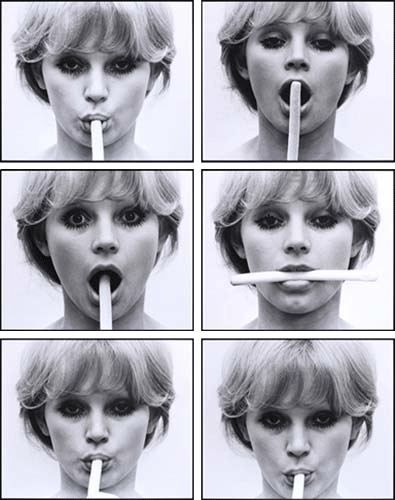
Consumer art, 1973
photographs 6x 50x60cm
1974
Becomes the curator of Drawing Triennale in Wrocław. Presents drawing works from the cycle “Morphemes” (1973— 1976) where form-modulus is transformed. In her text “Visual language” (presented in the film “Live Gallery” by Józef Robakowski and printed in the catalogue of her exhibition in Innsbruck in 1975) she states:
“Had art been identical with life most probably it would have disappeared among daily activities and behaviour. Reality as presented or described by art does not fit the image created by cognition based on everyday experiences. I destroy and fight those common and schematic experiences: seeing does not mean thinking.
Art seems to operate within very complicated structures both semantic and morphological. I would advocate a constant development of research aiming at creating “uncommon” and “impossible” structures to be realized in everyday reality. The goal of this research is to elaborate the records which cannot be materialized or the materialization of which will be exceedingly difficult. Experiences from reality are necessary only as far as the formulation of morphology of signs, therefore they will serve to create the signs of possibly perfect translucence in respect to that reality.
Finally the visual language will be comprehensible only within the limits of the image itself and any anecdotic motivation will loose its sense. In this way art will become art.”
Individual exhibitions:
— Verborgene Seite (Intimate Sphere), Paramedia Gallery, West Berlin
— Gruppo PERMAFO (with Z. Dłubak and A. Lachowicz), Universitario Platenese, Buenos Aires
— Consumer Art (TV realisation at Festival of Contemporary Music, Wrocław
Participation in exhibitions:
— V International Biennial of Graphics, BWA Cracow
— Experiences and Searches, Muzeum Sztuki, Łodź (Consumer Art)
— New Generation, National Museum, Wrocław (drawings)
— Polnische Gegenwartskunst 1945—1973, Wilhelm-Lehmbruck-Museum, Duisburg (works: Intimate Sphere, 24 hours)
— IV Triennale of Drawing, Wrocław participation in the film “Live Gallery” by Józef Robakowski
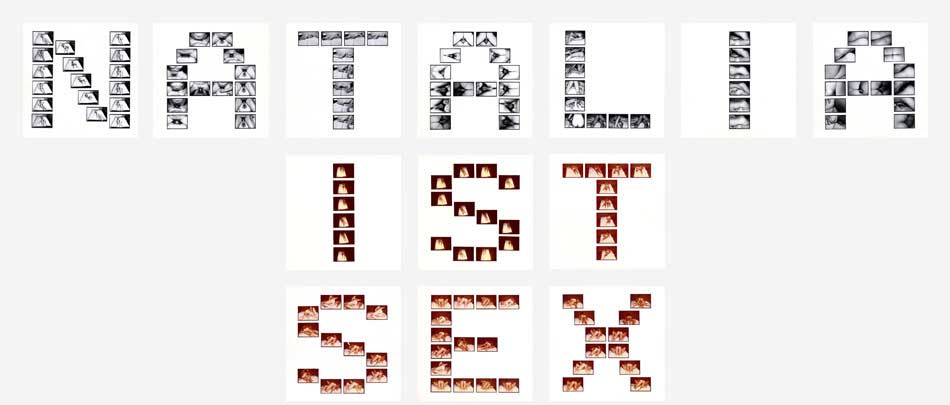
Natalia ist sex, 1974
photographs 13x 60x60cm
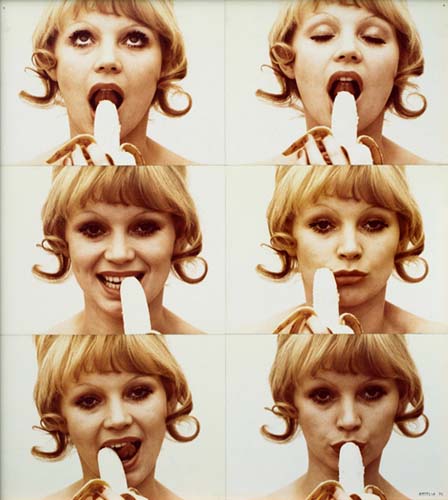
Consumer art, 1974
photograph 88x80cm
1975
Creates the cycle “Post-consumer Art” — series of photographic pictures, each linked with the specific text (so called: Categorical Statement). Engages in feminist art movement in Europe. Writes the text “Art and Non-Art”, arguments from which appear also in the work: “Categorical statements from the sphere of post-consumer art” composed of 9 parts. “Art and Non-Art” (fragments):
“… For if the model of reality in science has been created by means of the rational and experimentally sustained principle of cause and effect, the intellectual model of art is formed by art itself. Art is an a-dialectical formalization, or more precisely, an extra-dialectical one, as no rightful or reasonable motivation can be set forth outside the formalization itself. This leads to a paradoxical situation for if we really want to come to know art better, we must define it with art. The tautology of such an approach is confirmed by the work of many artists which in fact consists in exploring the possibilities of art. A good example can be here the Fluxus movement, and recently the intensive and specific work done by women artists with a feminist bias. (…)
I am, however, deeply convinced that there is a possibility of extending the area of art penetration by employing the eidetic, soul-fathoming method of cognition. For this admits of constructing a relatively precise and intrinsically non-controversial model of art which would be composed of elements of self-recognition and self-determination of art. Such a model would be capacious enough to contain all tendencies and kinds of formalization. So I postulate that a formula be worked out that would conclusively separate art from non-art and maybe even allow of evaluating operations (…) So maybe art is a product of that part of our consciousness which is based on extra-logical cognition. Then art would surely be a product and picture of the function of the human brain, its elements would be composed of the same matter as man’s brain, but would in fact be non-material for they would be composed of the soul or consciousness of the creator (…)”
Individual exhibitions:
— “Consumer Art” and performance “Natalia”, Art Centre, Beograd
— Consumer Art (exhibition and film projection), Współczesna Gallery, Warsaw
— Natalia, Studio 46 Gallery, Torino
Participation in exhibitions:
— Aspects of Contemporary Polish Art, Współczesna Gallery, Warsaw
— Flash Art Speciale Photographie, Galeria dell Milione, Milan
— Information and Emotions, National Museum, Warsaw
— IX Biennale de Paris, Musee d’Art Moderne, Paris
— 4th Meeting Festival Art, Beograd (films and photographs)
— Frauen Kunst — Neue Tendenzen, Krinzinger Gallery, Innsbruck (exhibition of feministic art)
— Magma, Brescia (exhibition of feministic art)
— Atuele Kunst uit Polen, exposed in: Eindho-ven, Apeldroon, Breda, Emmen
— Intentional Architecture, Museum of Architecture, Wrocław
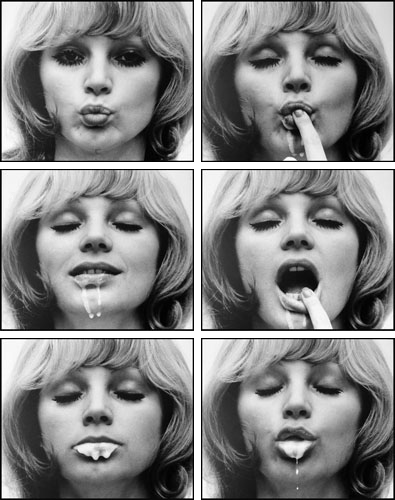
Post-consumer art, 1975
photographs 6x 50x60cm
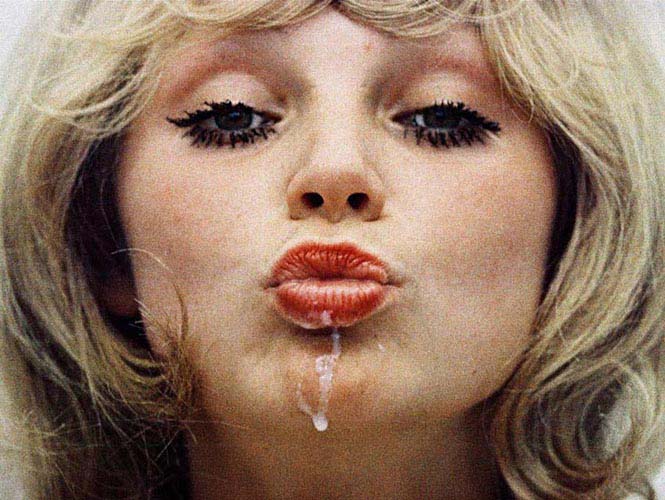
Post-consumer art, 1975
photograph 100x134cm

Post-consumer art, 1975
photograph 100x134cm
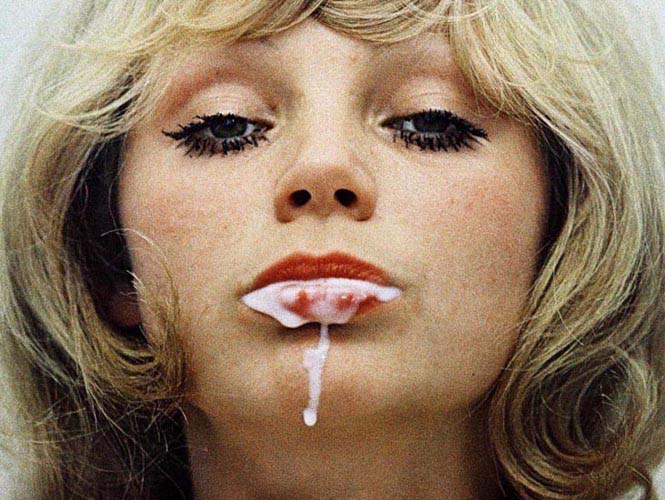
Post-consumer art, 1975
photograph 100x134cm
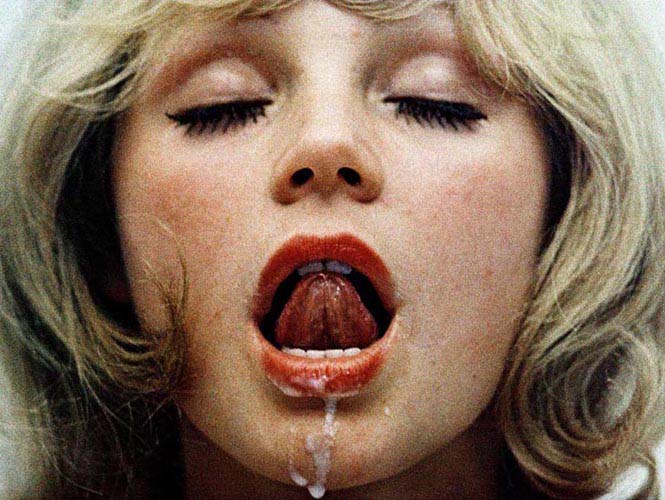
Post-consumer art, 1975
photograph 100x134cm
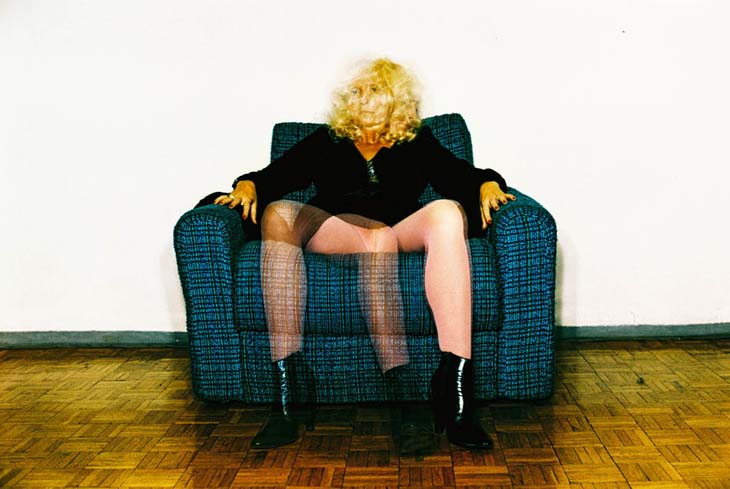
Artificial photography, 1975
photograph 100x125cm

Artificial photography, 1975
photograph 300x300cm
Artificial reality, 1975, 1976 (excerpts)
1976
Begins the cycle: “Artificial photography”, showing pictures impossible in reality what emphasized the existence of photography as an artificial language.
“Categorical Statements from the Sphere of Post-consumption Art (…) contain arguments being also postulates where the most important is the thesis about growing natural and visual complication of art — its increasing ‘artificiality’, until its final absolutisation and separation from reality (…) Art of Natalia LL is a movement, a process of growing artificiality (…) Each further stage of artificiality is necessary for constitution and confirmation of the previous stage — previous artificiality (…) It is the process of permanent condensation aiming to a pure notion (it embraces also a visual artificiality) where are contained all the other created until now notions and categories” (fragments from the text by Andrzej Sapija in the catalogue of the Natalia LL exhibition).
Individual exhibitions:
— Arte del post-consumismo, Galeria Diagramma, Milan
— Space, Gallery of Photography, Wrocław
— Exhibition together with Marina Abramovic and Gina Pane, Arte Verso Gallery, Genoa
— Altra Misura (together with Anette Messager, Suzanne Santoro, Stephanie Oursler), Galeria del Falconiere, Falconara — Ancona
Participation in exhibitions:
— Internationale Kunstmark, Cologne
— Photography as Art; Zagreb, Beograd, Maribor
— Atuele Kunst aus Polen, Rijksmuseum Twenthe, Enschede
— Arte Fierra, Bologna
— Offer, Labirynt Gallery, Lublin
— XI Biennale Internationale d’Art, Palais del’Europe, Menton
— Exhibition 12 Artists — ECART Gallery, Geneva
— Photography (exhibition accompanying Biennial of Graphics in Cracow), Arkady Gallery, Cracow
— Filmprojection, ZONA Gallery, Florence
— Frauen machen Kunst (feministic art), Galerie Magers, Bonn
— Photo-Idea, Galeria d’Arte Moderna, Parma
1977
3-months stay in USA on the scholarship from Kościuszko Foundation. Presents the development of feminist movement in art in the text “Feminist tendency”, uttered at exhibitions in Lublin and Katowice. Reports the main points of her own programme in art in the text “Permafo and others” (Nurt no. l, 1977; Data Arte, no. 27, 1977, Milan). In the text “Hypothesis” considers the problem of art and reality relations as it concerns the medium of photography.
Individual exhibitions:
— Exhibition together with Andrzej Lachowicz, BWA Białystok
— Artificial Photography, Milchstrasse Gallery, Freiburg
— Categorical Statements from the Sphere of Post-consumption Art, Labirynt Gallery, Lublin
Participation in exhibitions:
— Magma, Museo Castelvecchio di Verona, Verona and Palazzo dei Diamonti, Ferrara
— Boundary stages of photography (exhibition and symposium), ZPAF Gallery, Katowice
— La Carte Postale, Malacorda Gallery, Geneva
— Frauen machen Kunst, Wolfsburg Castle
— 03-23-03 Project/Performances, Museum of Contemporary Art, Montreal
— CEAC-Video, Center of Art, Toronto
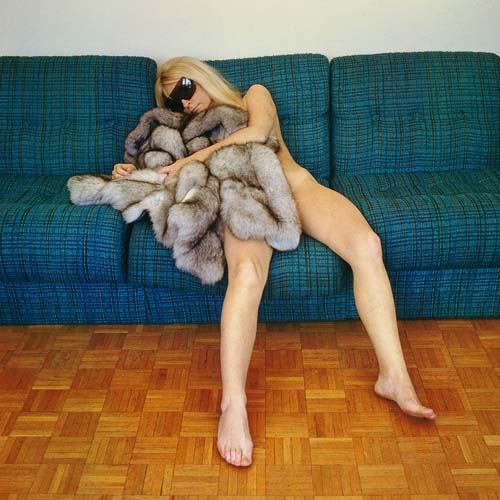
Animal art, 1977
photograph 100x100cm
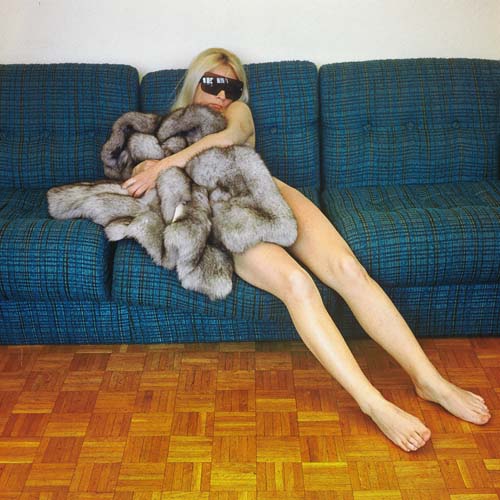
Animal art, 1977
photograph 100x100cm
1978
Begins the series of seances (performances) entitled “Dreaming” and “Points of support”. “Dreaming” was presented in different forms; the artist was sleeping during some events in the presence of a public, some seances were made in isolation before camera, in a pyramid, and she also photographed sleeping people. In the text “Dreaming” she wrote among others:”The superiority of the mental process to the visual perception is a fiction which must be — in art — resolutely opposed. The apparatus of visual perception (the eye and brain) is an inseparable entity for we cannot perceive with a vacant mind.(…) Art is a structure which allows of paralogical operations for it has this extraordinary quality that it develops on the basis of intuitive cognition. (…) The innate limitations of art do not mean that cognition through art is less valuable than cognition through science. Art, being more closely related to the whole psychological system of man, is, so to say, intrinsically inconsistent, just as man is inconsistent. These inconsistencies, however, bear witness to his complexity which is the motive power of his evolution and development.(…)”
“Dreamings” were a probation to visualize the most intimate, usually unconscious experiences and proved they cannot be translated. Intimacy meant here not inner isolation but being sensitive for subtle impulses coming both from inside and outside. Seances “Points of support” showed treating a body as an antenna receptible of the whole universe influences.
Since 1978 she has collaborated with a group of psychologists and physicists (among others Marian Krzysztan, Marian Wasilewski, Bonawentura Kochel). In a model of Cheop’s pyramid erected in the suburbs of Wrocław and intended for psychotronic experiments, she carries out séances of “Dreaming”. Acts as the curator of the 1st International Drawing Triennale in Wrocław
Individual exhibitions:
— Arte del post-consumismo, Gallery 16/e, Turin
— Problem Exhibition (with Andrzej Lachowicz), Studio Gallery, Warsaw
— Seance “Dreaming”, Museum of Architecture, Wrocław
— Seance “Points of support”, Czorsztyn (and the text of interpretation)
Participation in exhibitions:
— Women’s Art, Jatki Gallery, Wrocław (organized by Natalia LL with participating: Carolee Schneemann, Noemi Midan, Suzy Lake, and exhibited then in Lousanne)
— Presentation, Gallery of Critics, Warsaw
— La post-avanguardia, Centro Experimenta, Naples
— VI Biennale Internationale delia Grafica d’Arte, Florence
— Contemporary Art of Wrocław, National Museum, Wrocław
— The other media, Studio Gallery, Warsaw
— Art as the extreme of consciousness, BWA Szczecin
— Extreme Art, Gallery ON in Poznan and PERMAFO Gallery in Wrocław
— Graphics (Methods, Attitudes, Tendencies), BWA Cracow
— Zeichnungen fuenfzehn polnischer Kunstler, Museum Leverkusen, Leverkusen
— XV Biennale International Arte, Sao Paulo
— International Art Manifestation: Works and Words, Galerie de Appel, Amsterdam
— Documents of reality, National Museum, Warsaw
— VI British International Biennial of Prints, Bradford
— Gruppo PERMAFO, Centro Indiscreto, Rome
— Polish Art, Center of ELAC, Lyons

Dreaming 1/3, 1978
photograph 85x120cm
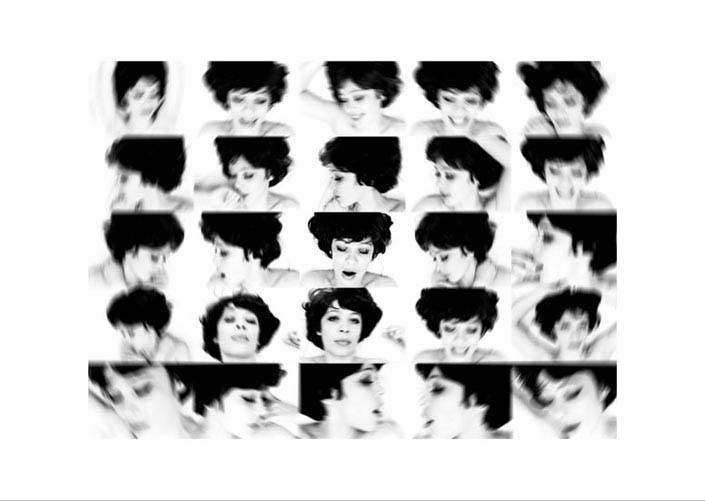
Dreaming 2/3, 1978
photograph 85x120cm
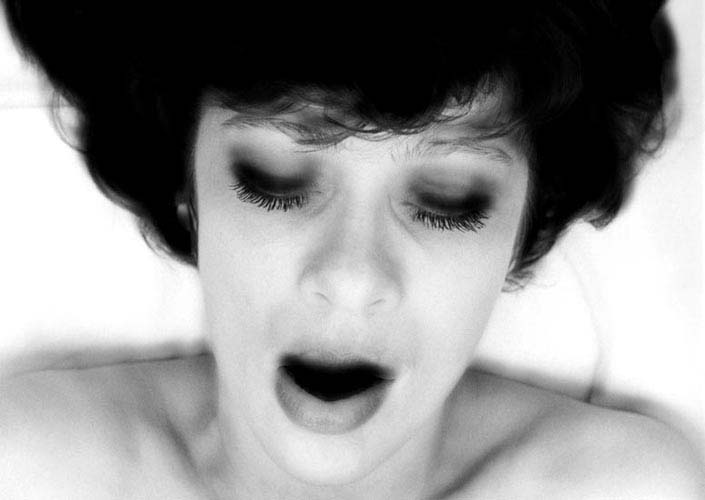
Dreaming 3/3, 1978
photograph 85x120cm
1979
Continues the “Dreaming” series. Commenting it she wrote (Dream and Reality): “‘Dreaming’ is a continuation of my interest in commonplaceness and triviality as an area of artistic penetration. The programmatic artificiality of art, postulated before, manifests itself through banal and humdrum activities such as eating, sitting or breathing.(…) Thus dreams are the substance of the ‘inwardness’ of this stage of the performance and are only experienced by the sleeper. Another aspect is the visual condition, the ‘outward’ layer of ‘dreaming’ perceived by the viewers, the participants-witnesses and the seance utensils in the gallery. A third aspect is an attempt to materialize, create an equivalent of illusive dreaming, construct a fictitious document. Of course, I am aware of the defects and fragmentariness of such a procedure, hence this supplementary commentary as well as a commentary during the seance. The sense of this procedure reveals to us how closely our ‘inwardness’ is bound up with us and that it is by nature untranslatable (…) But all realities appearing in an individual dreams exist as an idea which on the one hand emphasizes the substantiality of real consciousness, but on the other, being a play of appearances, brings the extreme values of individual consciousness into the sphere of public consciousness”.
The other her text about “Dreaming”, entitled: “Art as an inner experience”, was published in the booklet by PERMAFO Gallery “Unidentified Energies” in 1981. Publishes her text “Drawing Triennale — Triennale of Art”, presenting her artistic justifications as the curator of the exhibition.
Individual exhibitions:
— Dreaming, Mała Gallery, Warsaw
— Seance “Reading St. John of the Cross”, BWA Poznań
— Seance “Dreaming” (video show), Mała Gallery, Warsaw
— Seance “Dreaming”, PERMAFO Gallery, Wrocław
— Seance “Dreaming”, Wielki Młyn Gallery, Gdańsk
— Seance “Tocco delia Storia” (with Achille Cavellini), Vespasian Forum, Brescia
— Several seances of “Dreaming” entitled “Pyramid”, performed in the big model of pyramid, Wrocław-Stabłowice
— Exhibition “Pyramid”, PERMAFO Gallery, Wrocław
Participation in exhibitions:
— The Image of Man in European Art since 1945, Amsterdam
— Polish graphics, National Museum, Wrocław
— 35 years of painting in Polish Peoples Republic, National Museum, Poznań
— Polish photography 1939—1979, ICP New York
— Photography as art — Art as photography 3, Kassel, London, Coimbra, Lisbon, Barcelona
— Feministische Kunst Internationale, Gemeentemuseum, The Hague
— Natalia LL and Andrzej Lachowicz: Photography, National Museum, Wrocław
— Feministische Kunst, De Appel Gallery, Amsterdam
— Photographie als Kunst 1879—1979, Kunst als Photographie 1949—1979; Museum des 20. Jahrhunderts in Vienna, Linz, Graz, Innsbruck
— Extreme art: borderlands of consciousness, BWA Poznań (exhibition made by PERMAFO Gallery)
— Polish Contemporary Graphics, National Museum, Wrocław
text: Adam Sobota